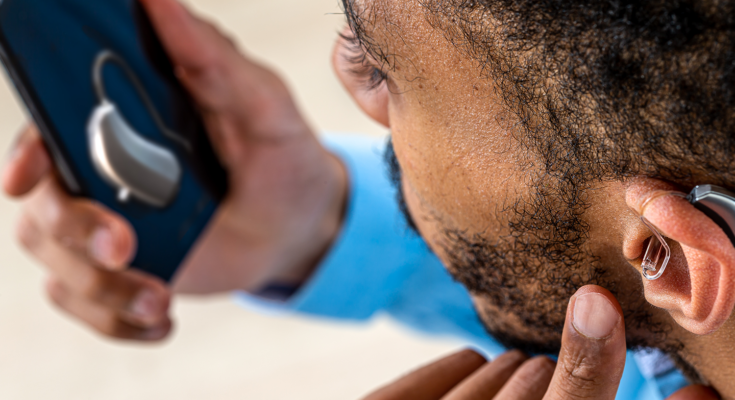Score 4.53/5
Price per pair $799–$1,995, depending on basic or premium package
Type of hearing aid Receiver-in-canal
Battery type Rechargeable (Enhance Select 100 and 200)
Bluetooth capability In-app adjustments, remote support, and streaming (hands-free calling also available on Enhance Select 200)
How to adjust App or buttons on hearing aid
Warranty length One to three years, depending on basic or premium package
Trial period 100 days
Financing Yes
Jabra Enhance Select hearing aids are the product of a partnership between sound tech company Jabra and the hearing aid manufacturer formerly known as Lively. The company’s top two models, the Enhance Select 100 and Enhance Select 200, both offer rechargeable batteries with an impressive length per charge, and it has several quick-charge options, making this brand our pick for the best rechargeable OTC hearing aid.
Appropriate for adults with mild to moderately severe hearing loss, Enhance Select devices (like all OTC hearing aids) can be purchased online without a prescription. Both rechargeable models are the receiver-in-canal style, offer Bluetooth streaming, and can be purchased with a basic or premium package option. The 200 model has eight listening profiles (versus four profiles in the Enhance Select 100) and hands-free calling with iOS devices and Android devices that have OS 9.0 or newer.
Battery Life and Charging Options
Jabra Enhance Select hearing aids offer the longest battery life of any hearing aid we’ve seen from an online manufacturer. A three-hour charge gives you up to 30 hours of power. Keep in mind, though, that hearing aid batteries drain faster when you use features like Bluetooth streaming, so this number will be affected by the amount of time you use Bluetooth to stream calls, music, or videos. Among the brands we’ve researched, the Jabra Enhance battery life was equaled only by prescription models such as the Phonak Audeo Lumity, Signia Pure Charge & Go AX, and Widex Moment.
Jabra Enhance also has two quick-charge options. A one-hour charge will give you 15 hours of use, the same amount you’d get on a full charge with Eargo or Audicus hearing aids. If you’re in a hurry, just 10 minutes of charging will add 2.5 hours to your battery life. And the charging case holds three full charges, a feature that active people and those who enjoy traveling may find convenient.
Should You Buy Rechargeable Hearing Aids?
Many people with hearing loss are looking for the ease of use afforded by rechargeable hearing aids. Our survey of 600 hearing aid users found that people wanted rechargeable batteries more than any other feature except for digital noise reduction, which is a standard feature in all hearing aids on this list, except Audien.
Manufacturers are paying attention to consumer demand. In the past year, our reviews team has seen multiple companies move away from disposable batteries, and that trend is likely to continue. Phonak, for example, offers no disposable battery options among its newest line of Lumity hearing aids, and Audicus now has rechargeable models in three of its four products.
For the majority of people, it’s simpler to place their hearing aids in a charging case than to routinely change out tiny batteries. When we tested more than a dozen hearing aids, our reviews team found it challenging to replace disposable batteries without dropping them. People with dexterity, coordination, or eyesight issues could find it even more difficult.
In some cases, disposable batteries might be a better choice than rechargeable ones. Stefanie Godbey, a doctor of audiology and clinician at Ohio Hearing and Audiology in Cincinnati, says that some of her patients prefer disposable batteries due to their lifestyle. One of her patients, for example, is an avid hiker and doesn’t always have a place to charge his hearing aids. In our focus group of hearing aid users, several participants who frequently travel said they enjoyed the ease of carrying batteries on trips, avoiding the need to stop and charge their hearing aids when the battery is low.
Three other considerations when deciding on battery type are:
- Cost Rechargeable hearing aids often cost more than disposable batteries. Rechargeable models from Jabra Enhance, for instance, start at $400 more per pair than a model with disposable batteries. Over time, though, you may end up saving money by not having to buy disposable batteries.
- Eco-friendliness Disposable batteries, although small, are not good for the environment. They contain heavy metals that can stay in the soil for years or run off into waterways.
- Safety risks Disposable hearing aid batteries and other types of button batteries, such as those found in remote controls, key fobs, and some toys, can present a dangerous safety risk. The National Capital Poison Center (NCPC) states that if button batteries are swallowed, especially by young children or pets, they can cause internal burns and even death in as little as two hours.
Older adults are also at risk of ingesting batteries. The NCPC warns that adults who have swallowed hearing aid batteries often do so because they mistook the batteries for pills. Any type of battery ingestion is a medical emergency and should be treated at your nearest emergency room as soon as possible. Call the 24-hour National Battery Ingestion Hotline at 800-498-8666 if you suspect that you or a loved one has swallowed a battery.
While lithium-ion batteries are the most common type of rechargeable battery and would also be harmful if swallowed, the risk of poisoning is much lower because rechargeable batteries are not removable in most models. They stay in the hearing aid for the entire life of the device, which is generally about five years.
How to Buy Jabra Enhance Select Hearing Aids
Before or after purchasing Jabra Enhance Select hearing aids from the company’s website, you can send in the results of a previous audiogram or take the free online Jabra Enhance hearing screening. Based on your results, the audiology team will program your hearing aids and then ship them to you. After you receive them, you’ll have a remote appointment with a member of the audiology team to help you with set up and adjustments.
Along with the best rechargeability of any OTC manufacturer, Jabra Enhance provides the longest trial period (100 days), during which you can return your hearing aids if they don’t meet your needs. The company also offers the longest and most comprehensive standard warranty among OTC manufacturers. The three-year policy includes coverage for manufacturer defects, damage, and loss, but it’s only included with the premium package.
Jabra Enhance partners with Bread to provide third-party financing. You can make payments for up to 18 months with no interest, subject to your credit score.
For more information, read our Jabra Enhance hearing aids review.
Get Jabra Enhance at JabraEnhance.com.



